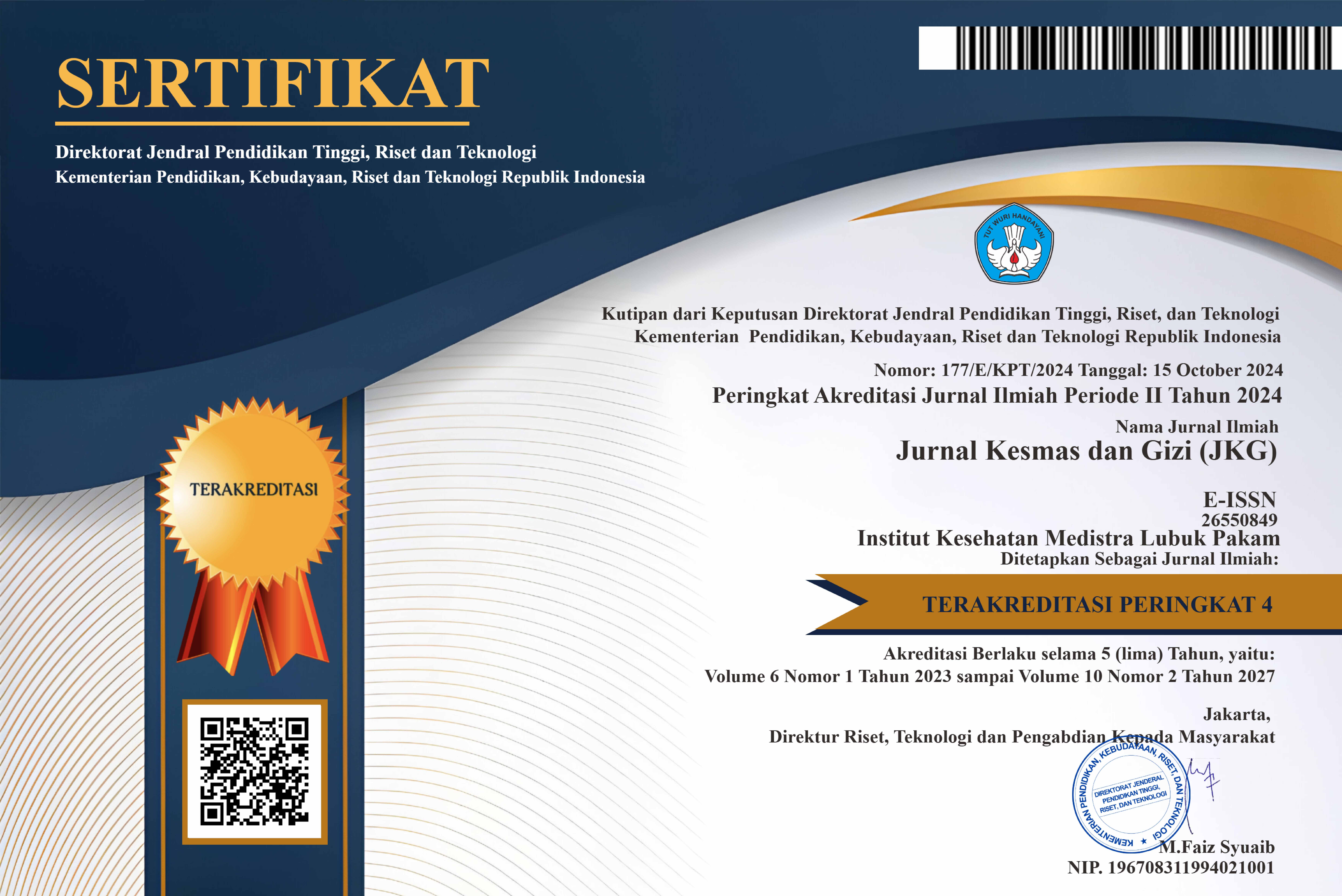KERAGAMAN MAKAN MINIMUM SEBAGAI FAKTOR DOMINAN STUNTING PADA ANAK USIA 6-23 BULAN DI KABUPATEN KUPANG
DOI:
https://doi.org/10.35451/jkg.v3i2.592Keywords:
Keywords: stunting, breastfeeding, minimum dietary diversity, meal frequency, and acceptable diet.Abstract
Background: Stunting in children is one of the things that most significantly hinders human development, which globally affects around 162 million children under 5 years (WHO, 2017). Kupang Regency is one of the contributors to the stunting rate with a prevalence of 46.2% in 2013 and increasing in 2019 to 50.3% (SSGBI, 2019).
Objectives: This study aims to determine the factors most associated with the incidence of stunting in children 6 -23 months in Kupang Regency.
Methods: This study used secondary data from the results of the 2019 YASATU NGO survey with the simple random sampling method, with a sample of 166 children aged 6-23 months. The variables analyzed consisted of the dependent variable stunting, the independent variables: maternal age and education, age and sex of the child, breastfeeding status, minimum dietary diversity, minimum meal frequency, and minimum acceptable diet.
Results: The bivariate analysis showed that there hadn’t a relationship between maternal age, maternal education, child age, child sex, breasfeeding status on the incidence of stunting. Meanwhile, there was a significant relationship between minimum dietary diversity (MDD), minimum meal frequency (MMF), minimum acceptable diet (MAD) on the incidence of stunting. The final result of multivariate analysis showed that minimum dietary diversity had the greatest Odds Ratio (OR=12,341; CI 95%=3,118-48,841). It was controlled by breastfeeding status, minimum meal frequency and minimum accpetable diet.
Conclusion: Minimum dietary diversity is a dominant factor of stunting in children aged 6-23 months in Kupang Regency. Children who did not meet MDD have 12,3 times higher risk of stunting than those who meet MDD.
Downloads
References
Akombi, B. J., Agho, K. E., Hall, J. J., Merom, D., Astell-Burt, T., & Renzaho, A. M.N. (2017). Stunting and severe stunting among children under-5 years in Nigeria: A multilevel analysis. BMC Pediatrics, 17(1),15. Retrieved from https://doi.org/10.1186/s12887-016- 0770
Biswas S., Bose K. (2010). Sex Differences In The Effect Of Birth Order And Parents’ Educational Status On Stunting: A Study On Bengalee Preschool Children From Eastern India. Journal of Comparative Human Biology. Retrieved from www.elsevier.de/jchb
JH Rah., Akhter N., Semba RD., Pee S., Bloem MW, et al. (2010). Low Dietary Diversity Is A Predictor Of Child Stunting In Rural Bangladesh. European Journal of Clinical Nutrition (2010) 64, 1393–1398 & 2010 Macmillan Publishers Limited All rights reserved 0954-3007/10
Kementerian Kesehatan RI. (2013). Laporan Hasil Riset Kesehatan Dasar Indonesia Tahun 2013. Jakarta: Kemenkes RI.
Kementerian Kesehatan RI. (2018). Laporan Hasil Riset Kesehatan Dasar Indonesia Tahun 2018. Jakarta: Kemenkes RI.
Kementerian Kesehatan RI. (2019). Studi Status Gizi Balita Terintegrasi Susenas 2020. Jakarta: Balitbangkes Kemenkes RI.
Noor, Rivani. (2015). Hubungan Indikator Pemberian Makan Pada Bayi dan Anak Umur 9-23 Bulan dan Faktor Lainnya Terhadap Kejadian Stunting di Posyandu Puskesmas Warung Jambu Kota Bogor Tahun 2015. Tesis FKM, Universitas Indonesia. Depok.
Picauly, I., Toy, S.M. (2013). Analisis Determinan dan Pengaruh Stunting Terhadap Prestasi Belajar Anak Sekolah di Kupang dan Sumba Timur, NTT. Jurnal Gizi dan Pangan, 8(1), 55-62
Ruwali, D. (2011). Nutritional Status of Children Under Five Years of Age AND Factors Associated in Padampur VDC, Chitwan. Health Prospect, 2011. Vol.10.
Triana, N & Haniyah, S. (2019). Relationship of Exclusive Breastfeeding, Complementary Feeding and Nutritional Intake with Stunting in Children in Karanglewas Health Center.1st International Conference on Community Health (ICCH 2019). Advances in Health Sciences Research, volume 20. Altantis Press
Unicef, WHO, World Bank. (2019). Levels and Trends in Child Malnutrition. Unicef/WHO/World Bank Group Joint Child Malnutrition Estimates. Key Findings of the 2019 edition.
WHO. (2010). Indicators for Assessing Infant and Young Child Feeding Practices Part 1 Definition. Geneva.
WHO. (2010). Indicators for Assessing Infant and Young Child Feeding Practices Part 2 Measurement. Geneva.
WHO. (2017). WHO Global Database on Child Growth and Malnutrition. Geneva. www.who.int.
Downloads
Published
Issue
Section
License
Copyright in each article is the property of the Author.


























